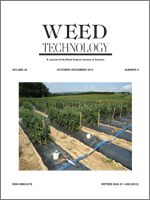Citron melon is a monoecious and hairy annual vine commonly found in citrus orchards and cotton and peanut fields. There is limited information available on citron melon control with PRE- and POST-applied herbicides in Florida citrus. Experiments were conducted to evaluate the response of citron melon to 11 PRE and 18 POST herbicides under greenhouse conditions. Indaziflam applied PRE at 0.095 kg ai ha−1 resulted in 13% citron melon emergence at 14 d after treatment (DAT). The majority of PRE herbicides did not affect emergence at 14 DAT. Efficacy of PRE herbicides at 21 DAT resulted in > 90% control of citron melon with bromacil, premix formulation of bromacil diuron, flumioxazin, indaziflam at 0.073 and 0.095, norflurazon, and simazine. Citron melon control was < 30% 21 DAT following PRE-applied diuron, oryzalin, and flazasulfuron. Control of citron melon varied by POST herbicides and growth stage. Regardless of citron melon growth stage, glyphosate, glufosinate, saflufenacil, paraquat, and flumioxazin provided > 90% at 7 and 14 DAT. Carfentrazone, flazasulfuron, imazapic, pyrithiobac-Na, rimsulfuron, trifloxysulfuron, and premix of 2,4-D glyphosate controlled citron melon at least 90% when applied to two- to four-leaf plants. Control was reduced when application was delayed to the six- to eight-leaf stage. Bentazon and halosulfuron controlled citron melon 11 to 31% regardless of growth stage. Biomass of citron melon at 14 DAT was reduced > 50% in all herbicide treatments except with bentazon and halosulfuron applied at both stages, and dicamba, mesotrione, imazapic, and rimsulfuron applied to six- to eight-leaf citron melon. The results of this study indicate that citron melon can be adequately controlled with several PRE- or POST-applied herbicides; however, research is required to evaluate PRE followed by POST programs or their tank mixtures for season-long control of citron melon under field conditions.
Nomenclature: Citron melon, Citrullus lanatus (Thunb.) Mats and Nakai var. citroides (L. H. Bailey) Mansf. CILAC; citrus, Citrus spp.; cotton, Gossypium hirsutum L.; peanut, Arachis hypogaea L.
Citrullus lanatus var. citroides es una enredadera pilosa anual monoica que se encuentra en plantaciones de cítricos y campos de algodón y maní. Hay poca información disponible sobre el control de C. lanatus con herbicidas aplicados PRE y POST en plantaciones de cítricos en Florida. Se realizaron experimentos bajo condiciones de invernadero para evaluar la respuesta de esta maleza a 11 herbicidas PRE y 18 POST. Indaziflam aplicado PRE a 0.095 kg ai ha−1 resultó en 13% de emergencia de C. lanatus 14 días después del tratamiento (DAT). La mayoría de herbicidas PRE no afectaron la emergencia14 DAT. La eficacia de los herbicidas PRE 21 DAT resultó en >90% de control de C. lanatus con bromacil, una formulación pre-mezclada de bromacil diuron, flumioxazin, indaziflam a 0.073 y 0.095, norflurazon, y simazine. El control de C. lanatus fue <30% 21 DAT después de aplicaciones PRE de diuron, oryzalin y flazasulfuron. El control de esta maleza varió dependiendo de los herbicidas POST y del estado de crecimiento. Independientemente del estado de crecimiento de C. lanatus, glyphosate, glufosinate, saflufenacil, paraquat y flumioxazin brindaron >90% a 7 y 14 DAT. Carfentrazone, flazasulfuron, imazapic, pyrithiobac-Na, rimsulfuron, trifloxysulfuron, y una pre-mezcla de 2,4-D glyphosate control





